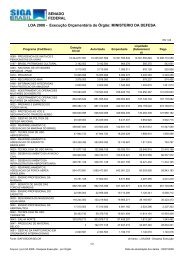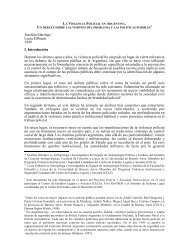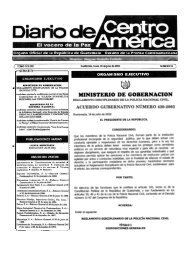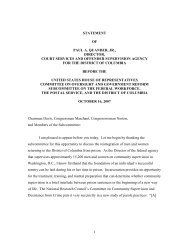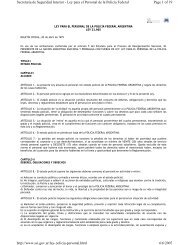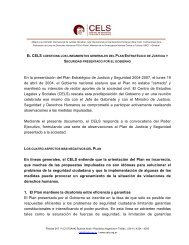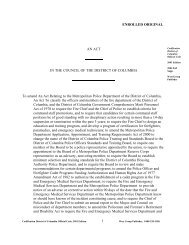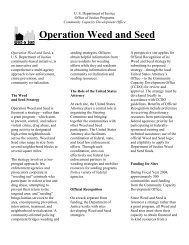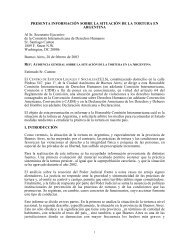Venezuela: The Life and Times of the Party System - Political ...
Venezuela: The Life and Times of the Party System - Political ...
Venezuela: The Life and Times of the Party System - Political ...
Create successful ePaper yourself
Turn your PDF publications into a flip-book with our unique Google optimized e-Paper software.
throughout <strong>the</strong> nation. Moreover, despite <strong>the</strong> fact that <strong>the</strong>se two parties now combine for a vote<br />
that recalls <strong>the</strong>ir joint total during <strong>the</strong> trienio, contemporary patterns are very different in structure.<br />
Trienio elections were wholly dominated by AD, but in subsequent votes <strong>the</strong> difference between<br />
<strong>the</strong> two parties’ national totals dropped steadily until 1968, when an alternating pattern begins<br />
(Table 6).<br />
How did AD <strong>and</strong> COPEI overcome decline <strong>and</strong> dispersion to achieve this impressive joint<br />
control? In retrospect, it is clear that a deft combination <strong>of</strong> strong organizational work <strong>and</strong><br />
effective media campaigning was decisive in helping <strong>the</strong>se two parties to push <strong>the</strong>ir competitors<br />
definitively to <strong>the</strong> margins. It is true that only AD <strong>and</strong> COPEI have <strong>the</strong> financial backing that make<br />
it possible to bear <strong>the</strong> heavy costs involved in such an effort. But in modern <strong>Venezuela</strong>n politics,<br />
money is necessary but not sufficient. <strong>The</strong> failure <strong>of</strong> electoral phenomena after 1968 suggests<br />
<strong>the</strong> importance <strong>of</strong> combining financial strength with organization.<br />
Alongside <strong>the</strong> AD-COPEI binomio, a few o<strong>the</strong>r noteworthy trends warrant separate<br />
attention. <strong>The</strong> data in Table 8 document a visible <strong>and</strong> growing gap in <strong>the</strong> share <strong>of</strong> <strong>the</strong> vote that<br />
parties receive for president <strong>and</strong> for <strong>the</strong>ir legislative slates. Part <strong>of</strong> <strong>the</strong> gap can be accounted for<br />
by <strong>the</strong> fact that smaller parties <strong>of</strong>ten latch on (as free riders) to <strong>the</strong> presidential ticket <strong>of</strong> major<br />
c<strong>and</strong>idates, <strong>and</strong> <strong>the</strong>ir votes thus inflate <strong>the</strong> total. But this does not account for <strong>the</strong> sharp increase<br />
registered in <strong>the</strong> two elections <strong>of</strong> <strong>the</strong> 1980s, where <strong>the</strong> two major parties each dropped about 9<br />
percent from presidential to legislative votes while <strong>the</strong>ir major competitor, MAS, rose by a similar<br />
amount. <strong>The</strong>se changes have o<strong>the</strong>r sources, most notably <strong>the</strong> electoral reforms <strong>of</strong> 1979 that, by<br />
uncoupling local from national elections, made it easier for small parties to target resources <strong>and</strong><br />
campaign efforts. This strategy has been followed successfully by MAS, not only in legislative<br />
voting but also, <strong>and</strong> most recently, in <strong>the</strong> newly uncoupled elections for state governors. We<br />
discuss <strong>the</strong> impact <strong>of</strong> recent reforms <strong>of</strong> <strong>the</strong> electoral system in <strong>the</strong> next section. Here it suffices<br />
to note <strong>the</strong> implications <strong>of</strong> <strong>the</strong> evolving pattern <strong>of</strong> competition for <strong>the</strong> internal dynamics <strong>of</strong> <strong>the</strong><br />
parties <strong>and</strong> for <strong>the</strong> way Congress is run.<br />
Rey (1990) has argued that <strong>the</strong> evolution <strong>of</strong> competition in <strong>Venezuela</strong> reordered <strong>the</strong> goals<br />
<strong>of</strong> party elites <strong>and</strong> reshaped <strong>the</strong> overall role that parties <strong>the</strong>mselves play in <strong>the</strong> political system.<br />
As threats to <strong>the</strong> system began to fade, emphasis on defense <strong>of</strong> democracy as a priority also<br />
faded, yielding to a stress on electoral competition with decreasing ideological content. Stress on<br />
party discipline remains, but <strong>the</strong> power <strong>of</strong> party leaders to convince <strong>and</strong> control all component<br />
sectors in<br />
<strong>the</strong> name <strong>of</strong> <strong>the</strong> party has dropped <strong>of</strong>f sharply. <strong>The</strong> growing independence <strong>of</strong><br />
organized labor from party discipline is only one sign among many.<br />
<strong>The</strong> emergence <strong>of</strong> two-party competition reflects successful efforts by both AD <strong>and</strong><br />
COPEI to occupy <strong>the</strong> center <strong>and</strong> to tailor campaigns around <strong>the</strong> satisfaction <strong>of</strong> a diverse range <strong>of</strong><br />
interests. Declining ideological difference <strong>and</strong> <strong>the</strong> consistent presence in <strong>the</strong> Congress <strong>of</strong> a



